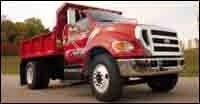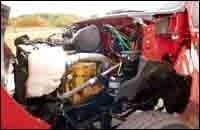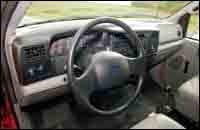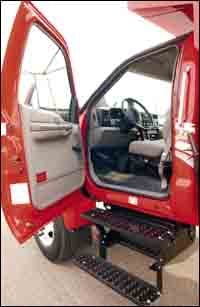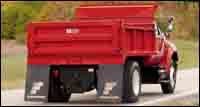Ford F650/750 Uphold Tough-Truck Tradition
Look around any jobsite and you'll see Ford trucks. Some may be shiny new and some old and beat up, but even the beaters probably run well and work hard. Ford really does build tough trucks, and when new they sell for less than a lot of others.
The toughness comes from solid design and careful manufacturing, thanks to a small corps of "truck people" within Ford Motor Co.'s automobile-oriented ranks. The comparatively low prices are made possible by volume components, primarily the cab from the perennially popular pickup line.
So it is with Ford's new F650 and F750 SuperDuty trucks and tractors, which use high-volume cabs from the lighter-duty SuperDuty pickup series. Economy of scale further improves because the cabs go on a 4000 series chassis from International—the highest-volume player in the Class 7 truck business.
The F650/750 medium/heavy-duty vehicles are the first products of the Blue Diamond joint venture between Ford Commercial Truck and International Truck and Engine. They are now in production on a special line at International's plant at Escobedo, in northeastern Mexico. The Blue Diamond (from Ford's blue oval and International's orange diamond logos) models are titled as 2004 models to distinguish them from '03 trucks built on Ford chassis. These are being phased out as production in Escobedo ramps up.
Ford executives showed off the '04 models to truck writers in late autumn at their Romeo (Mich.) Proving Ground, north of Detroit. We drove about a half-dozen F650s and F750s around the sprawling facility to experience their pickup-like comfort and quietness, solid handling and good power.
Also there for our driving edification were a few of the latest SuperDuty pickups, including one with the new 325-hp, 6-liter Power Stroke V-8 diesel. In a drag race, it whipped a Duramax-powered Chevy pickup, just as everyone expected, as the Duramax has "only" 300 horses.
The new Power Stroke with less horsepower (200, 215 or 230) but strong torque (520 to 620 pounds-feet) is standard in the F650. Optional are the 5.9-liter Cummins ISB with 185 to 260 horsepower, and the 7.2-liter Caterpillar 3126E with 190 to 300 horsepower. Eventually, International's inline six-cylinder diesels may join the lineup. Manual transmissions with 5, 6, 7 or 10 speeds and 5- or 6-speed Allison automatics are offered.
Class 5, 6 and 7 F650 series are rated at 17,999 to 29,000 pounds gross, while tractors are rated to 70,000 pounds gross combination weight. Class 7 F750s cover GVWRs of 30,000 to 33,000 pounds, and tractors have GCWRs of up to 80,000 pounds. The HN80 (now Sterling) sales contract with Freightliner prevents Ford from building tandem-axle Class 8 vehicles for another five years, but lift axles can be added by modification centers and dealers.
The F650s and F750s are smoother and quieter than one direct competitor, a GMC C6500 truck on hand for a driving comparison. Static display of models from Freightliner and International showed these have taller, roomier cabs. But the cabs are aluminum—a premium material that many buyers won't pay for, Ford people argued.
Ford's cabs are strong, economical steel. And they come in three styles: two-door Regular cab, four-door SuperCab and four-door CrewCab. International and Freightliner also offer three cabs, but their extended cab has no rear doors. The Ford SuperCab has a pair of rear-hinged doors for ease of loading and unloading tools, extra passengers, or whatever you want to stash back there.
Ford's cabs sit low on the frame, easing the climb for the typical medium-truck driver, who's in and out of the cab many times a day. Inside, I felt like I was in an F250 or 350, with the dash, most instruments and controls, and trim packages taken right out of the light-duty models. Folks used to Ford commercial trucks will feel at home, but those accustomed to a more "trucky" interior might think they've come down in the world.
Roof height is low, which is okay with low-slung bench seats but might be a problem with an optional individual air-ride driver's seat. This needs to be raised somewhat for its suspension to work fully, and tall people might find their scalps touching the ceiling. I'm short, so I didn't.
The windshield angles back steeply, which improves aerodynamics for highway cruising—something not overly important to a work truck—and the hood slopes steeply downward so I couldn't see the corners of the nose. But I quickly learned where they were, and everything in front of and to the sides of the truck were readily visible. Tight wheel cuts aided maneuverability.
I spent most of my time in a pair of F750s, one with a dump box (shown here) and the other toting a heavy utility body. The short-wheelbase dumper had a natty interior and an Allison MD automatic, so it was almost like driving a pickup; the longer utility/service vehicle was more of a truck, with a spartan interior and a Fuller six-speed manual.
Both trucks had Caterpillar 3126E diesels—the single most popular engine in the outgoing F mediums, according to marketers. Moderate loads in the trucks couldn't keep the Cats from propelling us smartly away from dead stops and up sometimes-steep hills.
Underway, the trucks have a solid feel and a smooth, steady ride, at least on the smooth asphalt and concrete roads we were confined to. How the trucks will ride on rough pavement is an unanswered question.
The cabs felt exceptionally tight and quiet. These are tributes to the efforts of engineers and designers and corporate willingness to spend money on development, as well as Mexican assembly quality. These may be lower-priced work trucks, but owners should do well and most drivers should feel coddled.

